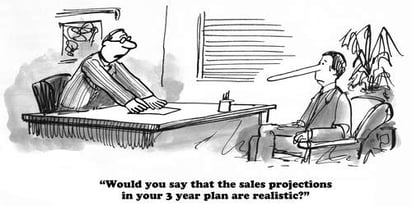
A CFO’s role is one of many hats. They are expected to be a steward by protecting company assets, have operational savvy, act as a strategist, and be a catalyst for positive change. There are many projects you would expect a CFO to facilitate:
- Facilitating M&A transactions
- Raising capital
- Overseeing Controller and internal auditing functions
- Helping accounting firms prepare for an audit
- Mentoring internal leadership
- Managing the organization’s overall risk and liquidity
- Driving growth initiatives
These are all areas where a CFO adds value to a business. But one of the biggest priorities of this role should be strategic planning. CEOs and boards increasingly want a CFO that not only gets the numbers right, but that also partners with them in strategic planning.
Consider the past year as a framework of some hard-learned lessons for many organizations. When the COVID-19 pandemic hit in early 2020, conversations with business leaders often centered around balancing strategy vs. value. In other words, businesses were forced to quickly pivot in the face of economic shocks while remaining sensitive to things like consumer and employee safety and market needs. Businesses that adjusted quickly with the help of agile leadership were able to survive and often thrive through unprecedented conditions, while others continue to struggle.
CFOs are playing an increasingly wide-ranging role in their organization’s business planning process and ultimate success. If strategic planning should be a CFO’s highest priority, here is an outline of strategic planning from a CFO’s perspective so that this role can make the highest contribution to its company’s planning process.
Knowing the Signals of a Weak or Ineffective Strategic Plan
A good strategic plan is the foundation of a successful and effective business. Spend enough time in the business world, and you’ll learn that having a sound strategy gives your organization a better chance for success.
But, as we have seen over the past year, strategy alone is not enough to guarantee success. No one has a crystal ball but having no clear strategy at all or a poorly-developed one is generally a recipe for disaster.
This begs the question; how can a CFO know that they are looking at a weak or ineffective strategic plan? If your organization’s plan has any of these features, it is likely going to miss the mark:
- Calling a List of Goals a Strategic Plan
Goals are excellent in and of themselves, but many go unaccomplished because they have no basis in reality. For example, if the foundation of your organization has not set you up to expand your operations or compete in a certain market, it would not support the weight of those goals.
Simply listing out goals because they sound “good” will not produce a strong strategic plan. To make a company’s vision possible, it must first create the right conditions to support it.
- Having Unclear Objectives
There is nothing wrong with having a roadmap, but long to-do lists are not strategic plans. Many business leaders will toil for hours and days over a plan with the intention of listing out every item that must be accomplished to reach a desired outcome. Instead, organizations should focus on one or a shortlist of action items that create a strong connection between the current state of the business and its purpose moving forward.
- Failing to Identify & Face Challenges
If your challenges go undefined or unaddressed, it is going to be tough to achieve what you lay out in your strategic plan. Too often, obstacles or challenges in a strategic plan are swept aside in favor of the more optimistic narrative. But an unaddressed challenge, like a global pandemic, could become the major stumbling block that sidelines the entire organization.
- Adding Unnecessary Filler
Fillers add no nutritional value to food, and they will not do much for a strategic plan either. In fact, a plan with an abundance of filler material tends to mask a lack of strategy. If you see a plan like this, it could be a red flag that not enough thought was invested where it matters the most - the vision and strategy.
The Benefits to CFOs of Strategic Planning
Done right, your company’s strategic plan can be a tremendous benefit. One study reveals that strategic planning has a positive impact on organizational performance. Strategic planning is effective because it fosters healthy business practices that drive more positive outcomes.
Making strategic planning a priority will benefit your business in multiple ways:
- You get quality data to support better decisions.
Having a strategic plan and the metrics in place to track your progress means you will have a source of meaningful data to access for reference. As a business leader, you can use this data to make more efficient and faster decisions that impact your employees, customers, and business at every level.
- You will maintain focus.
Having a strategic plan in place leaves no room for guesswork about your company’s or team’s focus. If someone wants to suggest a different path, you will not have to waste any time analyzing information if it does not align with your strategic plan.
- You build employee engagement and improve communication.
When organizations have a shared vision that is communicated consistently and clearly, it motivates employees to take ownership of their role in achieving goals, and many become more inspired to contribute their best efforts. This high level of engagement will directly impact your organization’s bottom-line results.
- You allocate resources more effectively.
As a CFO, you understand the importance of efficiently allocating resources. Your company’s strategic plan can help you structure your budget around key components of your strategy.
Linking your budget directly to goals makes it easier to adjust when priorities or circumstances change. For example, a local government that had infrastructure as a priority at the beginning of 2020 likely adjusted resources to support the urgency of a COVID-19 response.
The Steps to Take When Preparing a Strategic Plan
As a CFO, it is easy to get caught up in the whirlwind of activities that may or may not benefit your business in the long term. Without a cohesive plan, how will you know what to make a priority?
Before you can participate in the strategic planning process, it is vital to invest some time and resources in preparation. Here are a few steps to take as you get ready for strategic planning.
Get the Right People on Your Team
If someone in your organization has requested that you alone create a strategic plan and then submit the final product when it’s complete, this is the time to slam on the brakes. Why? For a plan to be most effective, it needs leadership and staff buy-in across the organization. This means you need others’ involvement from start to finish.
So, who are the major players you need for this process? As a senior manager, one of your roles should be to help create a cross-functional team. Your strategic planning team should include members of leadership or the board as well as representatives from operations, finance, sales, human resources, and any other critical functions.
Create a Reasonable Planning Timeline
Strategic plans are not something you bang out over a staff lunch or even a weekend retreat. To get your plan done or updated thoroughly, you need to allot a reasonable timeline to address all the inputs and outputs for your plan.
> If you refresh your plan annually, you might be able to work through this process in about four weeks.
> ?If you have never done a strategic plan before, the process could take several months.
If you expect a quicker turnaround, you could be selling yourself and your organization short.
Gather the Proper Inputs for Your Plan
Before you can “plan” anything, you need the proper inputs - also referred to as “data.”
>> Internal inputs- Is one area of your business growing faster than another? Are certain divisions or products thriving or struggling?
>> External inputs- What outside factors might play a role in your company’s performance? For example, do you get supplies from overseas? Is your industry facing fierce competition? Are there political factors to consider?
Once you have gathered this data, discuss it with your team to get their input. If necessary, you can also consult outside experts to determine how your organization is doing in comparison to others in the industry.
Combining all this data into a usual form is the final step before you can formulate your strategic plan. Most companies use a SWOT analysis, which is where you assess the following factors:
-
-
- Strengths- What are your company’s strong points?
- Weaknesses- Where could you use some improvement?
- Opportunities- What are some untapped areas you can explore?
- Threats- What are the biggest threats to your organization?
-
What a Company’s Strategic Plan Should Include
CFOs have the opportunity to help shape a strong strategic plan that positions the organization for success. Comprehensive strategic plans contain a variety of elements that help the business align its actions from top to bottom. Here are some of the main items that your plan should include:
Create or Confirm Your Vision and Mission Statements
Your company’s vision statement is its aspirational description of what it would like to accomplish, serving as a central guidepost for long-term plans. For example, the Boeing Company, which has its roots in the Seattle area, defines its vision as:
“Best in Aerospace and Enduring Global Industrial Champion.”
That is a lot of information packed into a short statement, but it acts as the guidepost for the company’s efforts.
Your company’s mission is the purpose that backs up its vision. In other words, it’s the “why” of the mission. Looking at Boeing again, the company’s mission is:
“Connect. Protect. Explore and Inspire the World through Aerospace.”
As you go through this exercise, you will want to create, confirm, or refine your organization’s vision and mission statements before moving forward with the rest of its strategy.
Build Out Your Plan
The next step is to build your strategic plan.
Set Your Objectives
Your strategy team needs to define what success will look like with respect to this plan so that it achieves the stated vision and mission. For example, some long-term objectives might include:
> Financial growth that exceeds $5 million over 10 years
> Increase revenue by 10% annually
> Improve customer satisfaction ratings by 5% annually
> Increase reliability of operations by 20% over 5 years
As you can see, these are all measurable goals, which helps make your team accountable for its success (or failure).
Develop Your Strategy
Once you have a list of well-defined goals, your team should create a separate strategy for each objective designed to achieve long-term success. If your goal is to increase revenue by 10% annually, what is the plan to get there? Will you cut costs? Release new products? Each strategy should also proactively identify any potential pitfalls that could make it difficult to achieve these objectives.
Outline Your Approach
Now that you have your set of objectives and have defined your strategy, the last step is to take a more granular approach to your plan and outline your steps. You can do this graphically, with strategy maps or timelines. Specifically, your representation will identify the strategic objective, stakeholders, KPIs, steps in the process, and a timeline for deliverables.
Identify Key Metrics (KPIs) to Measure Progress
Finally, how (and when) will you measure the progress of your plan? Many of your key metrics (KPIs) can be pulled from your list of objectives. For example, if one of your objectives is to expand markets, how can you measure this quantitatively?
It is also a good idea to continue meeting with your team periodically to gauge progress. A common mistake with strategic plans is to spend time creating them and then file them away. Instead, keep your plan top of mind, and the results have a better chance of materializing.
What Not to Do in the Strategic Planning Process
 Strategic planning has been around for years, which gives CFOs plenty of material to learn from based on the experiences of others. If you want to get the best results during and after the process, here are some common mistakes to avoid with strategic planning:
Strategic planning has been around for years, which gives CFOs plenty of material to learn from based on the experiences of others. If you want to get the best results during and after the process, here are some common mistakes to avoid with strategic planning:
- Do not start with the strategic plan. As we just went over, preparation plays a key role in the success of your plan. Give yourself plenty of time to get the right players on your team and to secure the supporting information you will need.
- Do not skip any steps or do some partially. The process works for a reason. Avoid tinkering with it unless you have data to support your changes.
- Do not lay out tasks before clearly stating your mission and objectives. You might have your heart set on a pet project, but your organization’s mission sets the stage for everything that comes next.
- Do not avoid measuring progress because “it’s hard.” Choosing meaningful metrics, setting up tracking, and using data correctly can be difficult, but that information can make the difference between the success and failure of your plan.
- Do not push people into roles without clear definitions and support. You will get much better buy-in for your plan and subsequent engagement if you involve employees at every level of the organization in strategic planning.
Need Assistance With Your Organization’s Strategic Plan?
With this information in hand, we hope that your team will have a new paradigm and approach strategic planning with a renewed outlook.
A CFO can be instrumental during the strategic planning process. If you need help with strategic planning or other projects, please reach out to us.
We will return your call or email on the same business day to schedule an initial consultation.
- After discussing your needs, we select the best CFO consultant based on their skill set, experience, style & approach, and cultural alignment. You will meet the CFO selected for an interview to ensure your satisfaction.
- If you are satisfied with the selection, you will receive a scope of work. You review the scope of work, and when you are ready, your CFO starts!
The average turnaround time for this process is three to four days, but it can be faster if needed. (Possibly by the next day.)
The CFO Selections team has a goal of complete satisfaction and follows up two weeks after the start of the CFO with a satisfaction survey.
Your new project CFO also has complete access to CFO Selections resources: Knowledge base, executive search team, bookkeeping support, backup coverage in case of absences, and additional team members to scale up as the situation warrants.
Contact us by phone, email, or form via the website.
About the Author
 Mark Tranter leads the business development and marketing efforts at CFO Selections®, which he joined in 2006 after co-owning a successful executive search firm. He organizes, hosts, and attends a large number of networking events, ranging from one-on-one meetings to roundtables, seminars, and forums. In this role Mark speaks with many business owners and executives who guide their organizations through transitions and transactions.
Mark Tranter leads the business development and marketing efforts at CFO Selections®, which he joined in 2006 after co-owning a successful executive search firm. He organizes, hosts, and attends a large number of networking events, ranging from one-on-one meetings to roundtables, seminars, and forums. In this role Mark speaks with many business owners and executives who guide their organizations through transitions and transactions.





